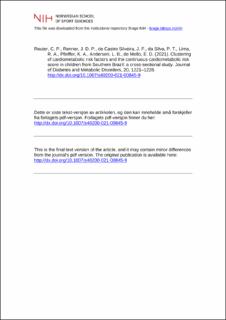| dc.contributor.author | Reuter, Cézane Priscila | |
| dc.contributor.author | Renner, Jane Dagmar Pollo | |
| dc.contributor.author | de Castro Silveira, João Francisco | |
| dc.contributor.author | da Silva, Priscila Tatiana | |
| dc.contributor.author | Lima, Rodrigo Antunes | |
| dc.contributor.author | Pfeiffer, Karin Allor | |
| dc.contributor.author | Andersen, Lars Bo | |
| dc.contributor.author | de Mello, Elza Daniel | |
| dc.date.accessioned | 2022-07-26T10:03:57Z | |
| dc.date.available | 2022-07-26T10:03:57Z | |
| dc.date.created | 2021-08-06T10:10:15Z | |
| dc.date.issued | 2021 | |
| dc.identifier.citation | Journal of Diabetes and Metabolic Disorders. 2021, 20(2021), 1221–1228 | en_US |
| dc.identifier.issn | 2251-6581 | |
| dc.identifier.uri | https://hdl.handle.net/11250/3008545 | |
| dc.description | Dette er siste tekst-versjon av artikkelen, og den kan inneholde små forskjeller fra forlagets pdf-versjon. Forlagets pdf-versjon finner du på link.springer.com / This is the final text version of the article, and it may contain minor differences from the journal's pdf version. The original publication is available at link.springer.com | en_US |
| dc.description.abstract | Purpose: The present study aimed to verify the clustering of cardiometabolic risk factors for cardiovascular diseases (CVD) and its relationship with the continuous cardiometabolic risk score (cMetS). Methods: Cross-sectional study with 631 children aged 6 to 9 years. Cardiorespiratory fitness, glucose, systolic blood pressure, total cholesterol/high-density lipoprotein cholesterol ratio, triglycerides, and waist circumference were assessed. The number of children in whom the risk factors were not independently distributed was analyzed. Z-scores were computed for each risk factor to calculate the cMetS. Results: There was a high proportion of children with clustering of risk factors for CVD. The clustering of risk factors was apparent in 11.3% of the children for four or more risk factors, and 21.9% had three or more risk factors. The cMetS showed a linear relationship with the increase in the number of risk factors. A cMetS value higher than 0.91 indicated clustering of cardiometabolic risk factors amongst children. Conclusion: The use of clustering of cardiometabolic risk factors identified a high proportion of children with the presence of relevant cardiometabolic alterations. A cMetS value higher than 0.91 (relative to an international standard) indicated higher clustering of cardiometabolic risk factors amongst children. | en_US |
| dc.language.iso | eng | en_US |
| dc.subject | cardiovascular diseases | en_US |
| dc.subject | child | en_US |
| dc.subject | metabolic syndrome | en_US |
| dc.subject | pediatric | en_US |
| dc.title | Clustering of cardiometabolic risk factors and the continuous cardiometabolic risk score in children from Southern Brazil: a cross-sectional study | en_US |
| dc.title.alternative | Clustering of cardiometabolic risk factors and the continuous cardiometabolic risk score in children from Southern Brazil: a cross-sectional study | en_US |
| dc.type | Peer reviewed | en_US |
| dc.type | Journal article | en_US |
| dc.description.version | acceptedVersion | en_US |
| dc.source.pagenumber | 8 | en_US |
| dc.source.journal | Journal of Diabetes and Metabolic Disorders | en_US |
| dc.identifier.doi | 10.1007/s40200-021-00845-9 | |
| dc.identifier.cristin | 1924322 | |
| dc.description.localcode | Institutt for idrettsmedisinske fag / Department of Sports Medicine | en_US |
| cristin.ispublished | true | |
| cristin.fulltext | postprint | |
| cristin.qualitycode | 1 | |
